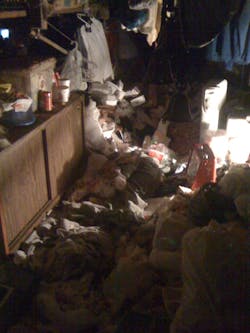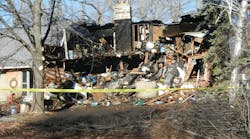The definition of hoarding is accumulating a large number of possessions that have no apparent value. With today’s popular reality show that is spreading the message on this subject, we all are more aware of this type of situation. Hoarders are becoming an ever-increasing problem in the modern world of firefighting.
Since the beginning of the fire service, we have dealt with stacks of belongings located inside and outside the buildings that we respond to with one major difference, today the numbers of these type buildings have become increasingly more common. The risks associated with fighting fires inside these conditions are increased due to the lack of room to maneuver, a larger fire load, and limited means of egress because the rooms are no longer able to be used for their intended purposes.
From the time of the Collyer’s Mansion in Manhattan, through today, firefighters have adapted to fighting fires in these situations. The most common answer to fighting fires inside these homes is to not go in. But are we really not going in or can we go in with some tactical changes? What are the determining factors in fighting offensively or defensively? Let’s take some time to review some tactics and establish the tasks used while fighting fires in hoarder homes.
Size-Up: The Exterior Picture
Just like any normal response, fighting fires in hoarder homes starts with a scene size-up that will allow responders to observe different areas for clues. A lot of these homes have cluttered yards or derelict cars out front. These exterior conditions are most often found in the rural areas that don’t have the stringent building codes, but that’s not always the case.
Noticing a yard full of stuff might mean the inside will be the same. Take a quick peek into any windows that allow an interior view for a better idea. You will definitely know you have a problem when you get to the door and it will only open slightly, if at all. With the use of these quick observations, coupled with the reading of smoke conditions, a first due officer can make the determination between offensive and defensive attack and adjust staffing accordingly.
Building Construction
While sizing up these buildings, we need to consider the structural integrity. Most hoarder homes are in poor repair and have tons of added weight stressing the structural members. These concerns are especially prevalent in today’s lightweight wood-frame construction. We also need to keep in mind the added stress that water will add to the already weighed-down structural members.
There are other considerations like rodents, insects, and unsanitary conditions. Many cluttered homes have been documented with infestations of rodents and insects. These conditions can prove to be a problem with fighting fires as you may encounter them trying to exit as you try to enter.
If entering these conditions in a non-firefighting activity, such as an EMS response, a responder may need to tuck in their pant legs and zip up their coat to keep insects from crawling up their legs or down their neck. An attack crew crawling into the home can use their hose line to sweep the floor to clear any crawlers they may encounter if the numbers prove to be a problem.
Offensive Considerations
Now that you have arrived and identified a manageable risk, let’s talk about some tactics for offensively fighting this fire.
The first consideration should be to establish a solid water source. A first arriving company officer should make the determination to wait until a hydrant line is established before entering this type of environment. Even the largest booster tanks don’t have enough water to absorb this type of heat.
While waiting on the water supply, the first attack line may elect to find the room closest to the seat of the fire and use an indirect attack. This should help reduce the size and spread of the fire while waiting on a definite water supply.
The second consideration should be the point of entry. Within hoarder homes walkways are limited. This can prove to be a labor-intensive task while managing even the smallest diameter attack line. The advancing attack team may have to knock over some of the smaller piles of belongings to even make their advancement to the seat of the fire.
As a hoseline is advanced through these “pathways,” it may begin to knock over debris. People have been killed by the collapse of these belongings when dry; imagine how heavy they will be when wet. It is imperative that the backup person try their best to keep this from happening. In a perfect world, an interior attack team would go to a three-man crew with the third person being responsible for removing or moving of debris if it falls on the hose. A debris collapse will make the hose line heavier and harder to move. All members fighting these fires need to keep in mind the dynamic ever-changing environment. The offensive attack may need to be changed at some point during the hose advancement.
Lessening the Danger
While a first line is being advanced into the structure to attack the seat of the fire, the outside crews can aid in the safety. Vertical ventilation is a key factor in limiting fire spread and making the interior more tenable for attack crews. In hoarder homes, this becomes even more important. Fire spreading along the ceiling of a these types of homes can catch the piles of belongings faster due to their height.
This horizontal spread, coupled with the increased fuel load, can make a flashover occur sooner and at a lower temperature than normal. Multiple vertical ventilation holes may be used to limit the spread in different directions.
The outside ventilation position becomes more important as well in hoarder homes. With direction and coordination, the outside windows can be removed and some of the piles can be pulled outside the window frame. This will allow for a better means of secondary egress for interior crews. A New York hook or Boston rake may be the tool of choice in this circumstance; they allow a longer reach and a better hold on the items to be pulled out.
As in any of our responses, communication between attack crew, outside ventilation crew, and incident commander is important, but in these conditions it needs to be increased. When fighting fires in hoarder homes, the communication should happen more often due to the increased work and fuel load on the interior crews. “Command to attack team 1…outside vent crew has opened up the window on the C Charlie side and began to remove debris…is this helping your condition?” “Attack crew to command…yes we acknowledge window on side Charlie and it is helping visibility.” This type of communication should be often and direct as possible.
Defensive Considerations
If conditions are to the point that an interior attack is not tenable, it’s best to pull crews out and regroup. Once outside you need to take in to consideration the normal worries of collapse zone, but must also be aware of some other considerations specific to this type of fire. The added weight of a hoarded home increases the collapse risk, so we need to be aware once your attack has become defensive.
Due to the compression and density of the conditions, some other tactics need to be used to increase your defensive attack. Opening windows and cutting them to the floor and breeching exterior walls can increase your reach with master streams and handlines. It will take more volume of water to put these fires out and stream penetration is a key factor that needs to be addressed. A solid bore nozzle is the preferred nozzle due to the stream shape and ability to penetrate the piles of belongings. Using portable monitors, such as the mercury nozzle, will aid in your operation as well. With the ability to apply a large GPM while using minimal amount of manpower allows you to reassign your people to help make access points and use more lines.
Salvaging and Overhaul Concerns
Once the fire has been extinguished, a new level on concern will appear…overhaul. Wow, where do we start?
The amount of labor-intensive work associated with the overhaul can be overwhelming. Once again, the limited pathways will prove to be challenging, so an alternative path to remove these belongings need to be explored.
A big concern with the overhaul of a hoarder house is the person’s connection to their belongings. The condition itself lends to the occupant not wanting to throw away any of their belongings. This could put us into a situation in dealing with owners. They may actually need to be removed from the fire scene in order to sort through the piles and extinguish the fire. While sorting through the belongings, remember the old adage that “one man’s junk, is another man’s treasure.”
Final Thoughts
Now that we have covered some of the concerns of fighting fires in hoarder homes, let’s take a quick review of what we have learned.
Hoarder homes are popping up in everyone’s district all across the country. Sooner or later you will be the one tasked with fighting these fires. These types of fires can be firefighter killers in an instant.
Having solid firefighting skills will help you when you are faced with a house full of stuff. Using one or more of the tactics discussed above will hopefully make it a little smoother or possibly save a firefighter’s life.
And, remember, when faced with this type of challenge, the best tactic may be not to go in! It’s one of the hardest decisions a firefighter will have to make.
RYAN PENNINGTON, a Firehouse.com Contributing Editor, is a firefighter/paramedic for the Charleston, WV, Fire Department. He is currently assigned to Station 8 and a member of the West Virginia Task Force 1 USAR team. He has over 17 years of combined fire, rescue and EMS experience. Ryan is currently a West Virginia State Instructor 2, Hazmat Technician, and Certified Fire Officer 2. Ryan has been guest on several Firehouse.com podcasts including: Training & Tactics Talk: Searching in the Modern Environment and Engine Company Operations in Today's Buildings. View all of Ryan's articles and podcasts here. You can reach Ryan by e-mail at: [email protected].








